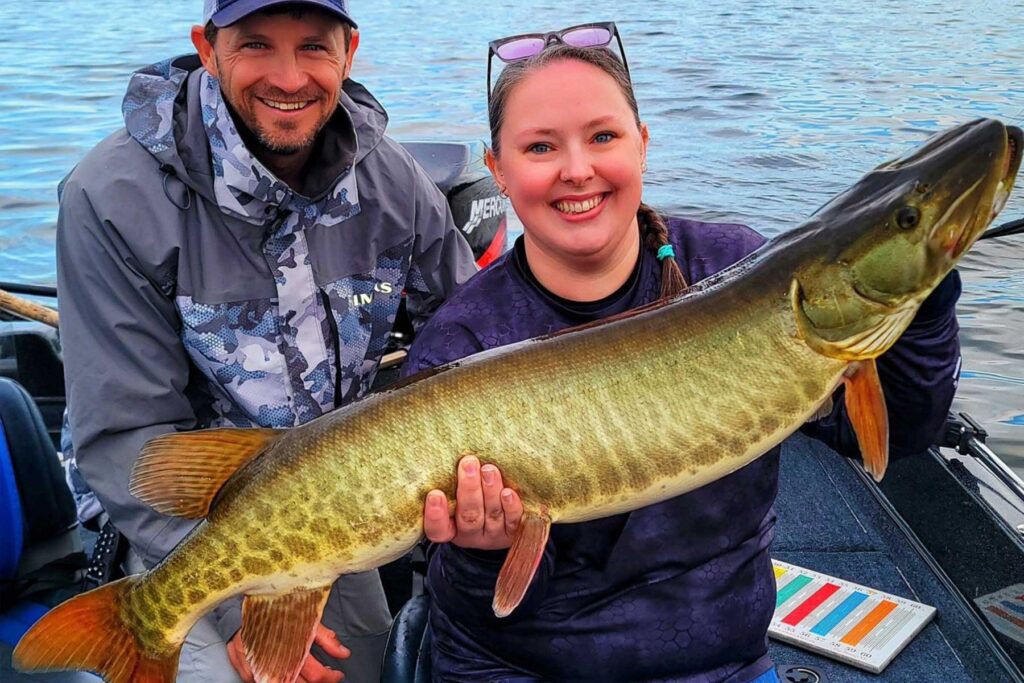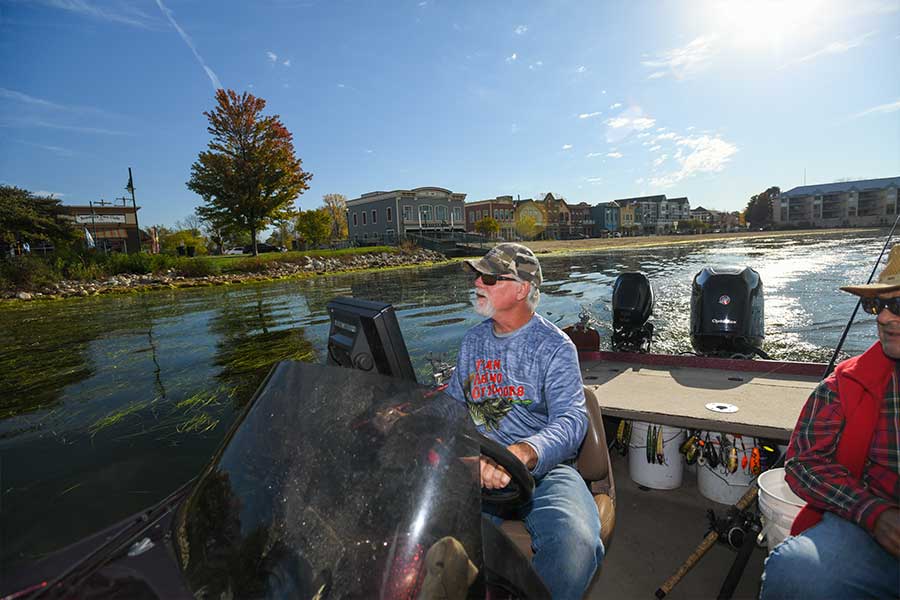
Fall on Pewaukee Lake means cooler temps and the best time to fish for muskies! Here’s a fun fact you may not know: Pewaukee Lake has the largest Muskie population in southeastern Wisconsin.
We spoke with Aaron Stack of Bitten For Reel Guide Service and Mike Koepp two of our community’s lead fishermen, for the 411 on what to expect for the 2024 Muskie fishing season and some great tips!
What are your predictions for fall Muskie fishing in 2024?
The cooler weather is bringing game fish like muskies back into the shallower waters from the deep cool water they were residing in summer.
Once water temperatures reach the lower 70’s the weed bite will start to get much better. The transition from deeper water to shallower green weeds will be the hot bite. This will get better with each day until mid-October when the weeds start to die off and water temperatures reach the low 60s. Once this happens the deepest greenest weeds will hold the most fish. By late October the “turnover” will begin around 57 degrees and then it’s time for live bait. Be safe on the water and respect others.
How should novice and experienced fishermen alike prepare?
The fall bite is the best casting bite of the season. Get your gear ready by checking your line, rod guides and reels. Make sure your equipment is ready to battle the big fall fish. Muskie fishing is hard on equipment. Most lost fish are due to a faulty line, leaders, snaps or bad hooks. Quality equipment is well worth the investment. Talk to your local shops. Dick Smiths Live Bait & Tackle or Smokey’s Musky Shop has the best info and experience. Most guides, local shops and employees at shops are also very informative and willing to help out in any way they can.
What are your TOP TIPs when it comes to fishing for Muskie?
The best advice we can give is to optimize your time spent on the water fishing key locations as well as these tips:
-
- While water is still holding the summer heat/warmer: The best places to fish for muskies are inside turns and points in the weed beds or pieces of stricture when fishing adjacent to deeper water. Baits to try include: crankbaits(slammers), deeper running bucktails(rocky Point Rage) and soft plastics (bulldawgs, medussas, red october tubes).
- As the water cools (sub 70s), adjust your tactics and move into the weeds a little more. Fishing tight to the edges where bait is abundant and hitting pockets in the weeds with spinnerbaits, bucktails, and soft plastics will be most effective.
- When the temps start getting closer to the 60-degree mark and below, live bait will become a bigger factor. Having a lively sucker close to the boat while working a bucktail, topwater, minnow bait, or glide bait over the still-standing green weeds and weed edges will yield results.
- Weather will play a factor in any given day. Severe cold fronts should suggest slowing down your presentations a bit. But all in all, fall can be a great time to put some late-season fish in the boat.
- To those fishing on their own, respect the resource and others on the water. Please have proper release tools for these fish. As big as they get, they are quite fragile. Hook cutters, long-handled needle nose pliers and a large enough net to act as a holding pen for the fish in the water will reduce fish mortality. Most importantly, have your camera and measurement tool ready before pulling fish out of the water. 20-30 seconds tops is all you need. Extended photo shoots and video recordings will increase the chances of losing a musky!
- Please give more than enough space (a healthy cast length) when working past another boat. If you see a boat working an area, get behind them a bit or go back to that spot later. Etiquette amongst fellow anglers speaks volumes.
Facts About Catching the Elusive Muskie on Pewaukee Lake
The average-sized fish is about 34-inches, but every once in a while someone manages to snag a 50-plusser. They thrive on Pewaukee Lake because there is an abundance of Yellow Perch, Black Crappie and Bluegills to forage, and the DNR propagation program provides an excellent muskellunge product that is stocked annually.
Those who have caught this mysterious fish more than likely have a fish tale to tell about how, where and what to use when trying to boat a Muskie, but most agree on the following tips:
- Open Water. Muskies do roam in open water and will chase schools of bait fish. The best methods for fishing include trolling crank baits, casting jerk baits or jigging large plastics. It also helps to look for areas where there are shoals and drop offs.
- Muskies like weedy areas, but in the fall, try to avoid dying weed beds and areas that lack enough oxygen for fish to live there. Green weeds are key to shallow water fall fishing.
- River/Creek Mouths. Some baitfish, like ciscoes, spawn in creeks in the fall and where there’s food, there’s Muskie.
- Rocky Points. Rocky points can be fish magnets, especially in the fall, and M muskies like to use the rocks as ambush points.
- Baits are a personal choice among anglers, but for fall, many say the bigger the better and to have at least 80-100-pound line. Most of the time, anglers catch and release Muskie, and in fact, it’s the law if the fish is under 50 inches. To make the most of your adventure, have all of your release equipment nearby. You’ll need a landing net and needle-nosed pliers to release the jaw.
Fishing Guides & Boat Launch Spots
It can take hours, days, years, heck, a lifetime to catch a trophy Muskie, so many fishermen rely on the expertise of fishing guide Aaron Stack from Bitten For Reel Guide Service to increase their chances of catching the big one.
If you want to venture out on your own, public and boat landing boat launch spots are available along Pewaukee Lake. Bring a friend and come check out Muskie fishing in Pewaukee this fall.



